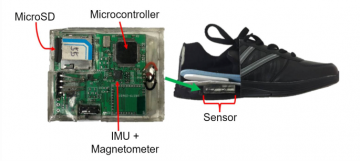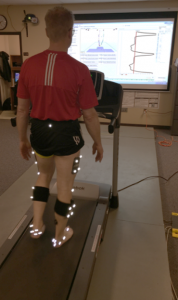Do those of us with knee osteoarthritis need biomechanical tune-ups to reduce the pain and progression of this chronic disease?
By: Sheila Kerr Posted: 8 January 2021
I love watching how people walk as there is so much variety. I note that some people with knee osteoarthritis (OA) tend to naturally adapt their gait by turning out their toes as they walk. There is a good reason for this as the adaptation can decrease joint pain and load.
Jesse Charlton, a PhD student at the UBC Motion Analysis and Biofeedback Lab, is currently running two studies on how people with knee OA walk:
- Whether people with knee OA have different walking patterns than those who don’t have knee OA.
- What changes can be made in the way individuals with knee OA walk in order to reduce joint loads and pain. How best to teach people to walk consistently with this new pattern as they go about their daily activities.
I have been chatting with Jesse about his two research projects.
Q: Jesse, can you tell us about the overall goal of your current research? Why study walking patterns in people with knee osteoarthritis?
A: For years now, we have seen that various aspects of how people walk are related to knee osteoarthritis. Every step we take imparts a load (or force) onto our body. There is a lot of research suggesting that when this load is excessive or abnormally distributed within the knee it can be problematic for people with knee osteoarthritis. Some load is good, in fact it is necessary for cartilage health, but when there is too much or it is focused on unhealthy cartilage, we can see increased pain and faster progression of the disease. One way to address this is to make small changes to walking patterns that shift the load away from areas of osteoarthritis. My research is focused on understanding how people learn these walking patterns and whether they can be integrated into normal daily life. Since much of the work in the past only takes measurements at a laboratory, I use new technology that lets me collect data while people walk about the world in their day-to-day activities. This gives us a much better understanding of the unique walking patterns that each person has. From this work, we want to know if these small changes to walking patterns can slow disease progression and improve pain, and if they are easy to learn and integrate into everyday life.
Study 1
Q: How do you measure walking patterns and joint loads in people with knee osteoarthritis?
A:This is where we get to play with some neat toys! I have two primary ways of measuring peoples’ walking patterns. In our lab, we use similar technology to modern video game or movie companies that do motion capture. We place small reflective balls on the person’s skin and a series of high-speed video cameras can track how they move around. We also use special plates in the floor that let us measure how the person impacts the ground as they walk. Captured together, this information allows us to mathematically model walking patterns and joint loads! The big limitation here is that walking in a small space like our lab doesn’t represent how people move in their daily lives. So, I also use small sensor devices that have similar technology to smart phones. We embed these sensors in shoes, so they are very discrete; the shoes look like a regular pair of runners from the outside! These devices allow us to capture walking motions wirelessly during daily walking activity.
Q: Who do you want to include in your study? Will you have a group of people without knee osteoarthritis for comparison?
A: We want to cast a wide net for this particular study. People WITH and WITHOUT knee osteoarthritis are potentially eligible. This study has several categories of participants:
- younger adults without knee OA or knee pain
- older adults without knee OA or knee pain
- older adults without knee OA but with knee pain
- older adults with knee OA and knee pain
Q: How often will the study participants have to go into the Motion Analysis and Biofeedback Lab at UBC? Have you followed all the COVID-19 protocols?
A: A very important question, Sheila! This study is relatively short as we are only looking to capture how people naturally walk in their daily lives. Typically, a participant can expect one screening appointment, an x-ray appointment (we work with a couple of clinics around Vancouver), and the official baseline appointment to begin the study. They would then take our customized sensors and shoes home for 7 days. I usually arrange to pick up the sensors and shoes at a location convenient to them after the 7 days.
As for COVID, we have put into action a number of procedures to ensure the safety of anyone who comes to our lab. Our small research staff of 2 will use masks and gloves, they will clean the lab prior to and after each participant, and we have implemented a COVID screening procedure to ensure everyone attending an appointment (staff and participants) is healthy. We take this very seriously and want to ensure our participants and staff are as safe as possible.
Q: How long and frequently will the participant have to wear the sensorized shoes? What size of shoes do you have available?
A: For this study, the participants take the sensors and shoes home for 7 days. We aim to gather 7 days of walking total, with about 20 minutes of walking in the shoes each day, minimum. Though, we commonly have participants wear the shoes for outdoor walks between 30 minutes and several hours. We have a variety of sizes available ranging from women’s 5 to men’s 13.
 Pictured above: The small sensor device (left) that measures walking motions and fits within the sole of a shoe.
Pictured above: The small sensor device (left) that measures walking motions and fits within the sole of a shoe.
Q: Will the study participants get a copy of their gait analysis showing the loading of their knee joints?
A: Yes, we are happy to provide a biomechanical report to any participant who desires one. We include several aspects of your walking that are relevant to knee osteoarthritis and provide comparisons of your results relative to our large database of past participants.
Q: Where can I sign up to see if I qualify to participate in this study?
A: Check out our website for more details on the study and to complete our online screening questionnaire!
Study 2
Your second study will look at changing how a person walks in order to alter knee joint loading. Previous research has shown that some people with knee OA benefit from walking with their toes pointing in and others with their toes pointing out.
Q: How will you decide which pattern is best for someone?
A: Much of the research in the past has only provided one standardized option (e.g. everyone practices toes pointing out). While this has worked, we believe that individualizing the new walking pattern can be more effective for specific people. During the screening appointment of the study we will have the participant walk with varying amounts of both toe-in and toe-out. I will perform a number of calculations to determine which is most optimal from a biomechanical perspective.
Q: How will you reinforce this pattern in day-to-day activities?
A: We want participants to change their toe-in or toe-out angle as much as they can, while still being relatively comfortable. We ask that they practice walking with this new pattern for at least 20 minutes a day. Outside of some focused practice, an easy rule of thumb is to perform the new pattern in as much of their daily walking as possible. This will help make it natural much faster! In the past we have used in-person practice sessions, but to ensure the safety of everyone in this COVID-era we will be using videoconferencing instead. We will have a weekly one-on-one videoconference (or phone) meeting to discuss how things are progressing and provide some guidance.
Q: How many times will study participants visit the Motion Analysis and Biofeedback Lab at UBC?
A: This study is a bit longer than the previous one since we are testing a treatment and the new walking pattern needs time to be learned! Participants would attend a screening appointment, x-ray appointment, and then an official baseline appointment. After six weeks of practicing the new walking pattern they would return for a follow up appointment. Four weeks later, a final follow-up appointment will be scheduled to see how the new walking pattern has worked since finishing the 6-week program.

Pictured above: A participant has the small reflective markers placed on their body so the cameras can track their walking motions in the Motion Analysis and Biofeedback Laboratory. On screen, the participant is receiving feedback of their foot motions in order to practice walking with their toes pointed out.
Q: What kind of participants are you looking for? Amount of pain, age, OA on x-ray….
A: Unlike the other study, this one is only including people living with knee osteoarthritis. We are looking for participants over the age of 50 years, with at least mild knee pain (equal to or greater than 3 / 10 knee pain), and osteoarthritis primarily on the inside of the knee (we check this with the x-ray). There are a few other criteria and questions we ask to ensure the study is the best fit for everyone who gets involved.
Q: Where do I find out more?
A: Check out our website for more details on the study and to complete our online screening questionnaire!
Anyone interested can take part in either study depending on their eligibility and how much time they have to volunteer. For those who want to try out an experimental treatment, enjoy walking for exercise, and want to improve their knee pain, the second study is a great fit!
Thanks Jesse. I think it would be fascinating to get a report of my personal walking biomechanics. We need to load our joints to keep them healthy and walking daily is a great way to achieve this. Practicing the new walking pattern that Jesse teaches you can help to get the healthiest knee load on every step you take.